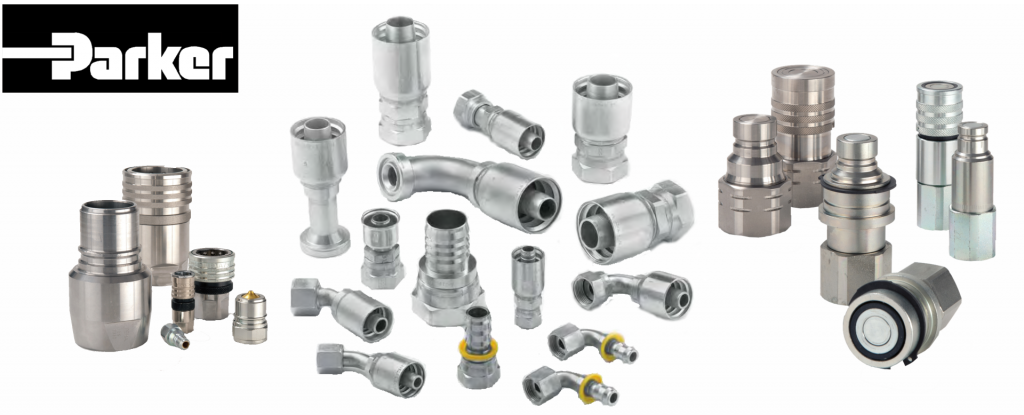 OEMs and fitting manufacturers are constantly finding new ways to stump us with different threads and new ways to seal them. Generally, however, when making hydraulic fitting connection choices today, there are several features to research and understand for your application. We highlight connections, attachment styles and the 5 most important factors you need to consider for hydraulic fittings.
OEMs and fitting manufacturers are constantly finding new ways to stump us with different threads and new ways to seal them. Generally, however, when making hydraulic fitting connection choices today, there are several features to research and understand for your application. We highlight connections, attachment styles and the 5 most important factors you need to consider for hydraulic fittings.
7 common end connection types
- JIC 37⁰ Flares: The Joint Industrial Conference (JIC) fitting is the most common hydraulic connection style. It consists of parallel threads and a 37⁰ cone on the fitting end that attaches to either a flared tube or hose fitting.
- O-Ring Face Seals: O-ring face seal fittings have flat sealing surfaces that contain an embedded seal, which mates to flanged tubing or hose fittings. Flat sealing surfaces reduce the risk of over-torqueing, and the captured seal prevents leakage.
- O-Ring Boss: The threads of the SAE straight thread O-Ring Boss (ORB) and the straight thread 37⁰ JIC Flare are the same threads. The difference is the way each thread seals. While the JIC seals on a metal-to-metal flare, the ORB seals on an O-ring, which offers the best leak free connection.
- Inch Compression: The inch compression fitting is a bite type fitting for hydraulic tubing and there are very limited hose connections for this style. This fitting can be assembled onto hydraulic hard tubing in the field with minimal tooling required.
- NPT Pipe Threads: NPT pipe threads are your traditional tapered thread fittings and have been used for 100 years. They are available in low-pressure black iron and brass, and high-pressure steel and stainless steel. This connection style is used in pneumatic and process systems and hydraulic systems.
- DIN Metric 24⁰ Bite Type: This is the most common hydraulic fitting style in Europe. As such, there is a full line of hose fittings for this style, and it can be used with metric-sized tubing. Newer versions of this fitting style incorporate a captured elastomeric seal on the mating surface, providing better sealing and reusability.
- Four-Bolt Flange: The 4-bolt flange connections conforming to SAE J518 and ISO 6162-1 and -2 are proven, leak-free connections and are especially suited for larger sizes, higher pressures and assembly in tight quarters.

2 differences among attachment styles
- Crimp Fitting: Using crimp fittings requires a crimping machine or a press to attach the fitting to the hose. If you don’t have a machine of this type in your shop or facility, a local Hydraulic distributor or supplier can fabricate the hose assembly. Locate a distributor near you.
- Field Attachable Fitting: The advantage of field attachable fittings (also referred to as reusable fittings) is that a machine isn’t required to attach the fitting to the hose. The hose assembly can be made anywhere provided that the fitting and the hose on hand is Field Attachable Fitting compatible. In most cases, a field attachable fitting consists of two pieces; a socket and a nipple.

5 factors for fitting selection
Below are the five factors you should consider when selecting the right hydraulic fitting for your application:
- Versatility: JIC fittings offer the best versatility of any of the aforementioned fitting systems. Additionally, there are available fittings that can connect JIC fittings to any foreign or American port, and jump sizes can expand or reduce between any sizes. A key benefit of JIC is the great variety of product that is typically stocked by vendors, including straights, elbows, long drops and male or female threads.
- Availability: JIC and NPT fittings have been the field standard for decades, and they are readily available in both volume and variety. As a growing number of OEMs converts to O-ring face seals and DIN metric fitting styles, any hydraulic hose shop should be able to identify these new fittings, but the selection may be limited. Click here to find your local Parker distributor.
- Pressure Rating: Many OEMs are choosing O-ring face seals and DIN metric fittings, as required pressure ratings have increased. JIC fittings are not rated for these pressure ratings, especially in high vibration applications. Similarly, NPT threads are not recommended for higher pressure. These applications require specially-rated fittings.
- Application: The application in which a fitting will be used is a critical factor in choosing the right fitting. The STAMP acronym applies to fittings as well as it does to hose. Size, Temperature, Application, Media and Pressure all must be taken into consideration when making this choice. The STAMP process is integrated in Parker’s HoseFinder app.
- Reliability: NPT pipe threads have always been popular, as leaks can be fixed by simply tightening the fitting. This practice, however, has led to cracked fittings. While JIC has been the industry standard for years, it still susceptible to cracked flares from overaggressive wrenching. The mated sealing surfaces in O-ring face seal fittings and DIN metric fittings reduce the risk of over torqueing, and provide greater reliability due to the elastomeric seal that is captured in the mating surface.
At the end of the day, all hydraulic fittings are only as good as the assembler who installed them. A general rule of thumb is to connect a hose with the least amount of connections possible. There are proper assembly procedures for each of the fitting styles, and strict adherence to those steps makes the difference between a solid connection and a problem waiting to happen.
(source: http://blog.parker.com)


